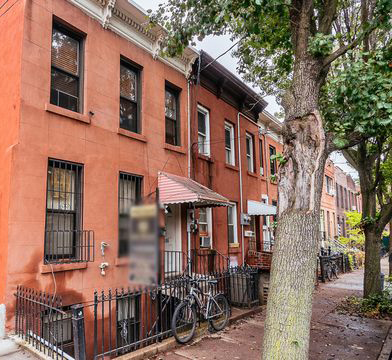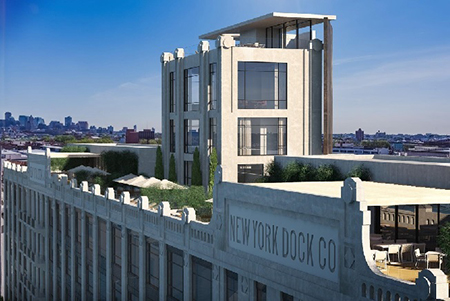 Brownstone Real Estate LLC. is committed to the Fair Housing Act under the New York State Human Rights Law. To learn more about it, please click here.
Brownstone Real Estate LLC. is committed to the Fair Housing Act under the New York State Human Rights Law. To learn more about it, please click here.
The old-time quaintness of Red Hook long ago made that area one of our favorite Brooklyn neighborhoods. The waterfront, the rows of low-rise homes everywhere along the narrow streets, the old warehouses along the end of Van Brunt Street and, now lost to IKEA, Beard Street gave it the feel of an industrial coastal town, while the mid-rise “Houses” projects remind us that this is an urban neighborhood that’s been marginalized by city planners for more than seventy years.
City planners be damned, the neighborhood is now eyed by other planners, those that plan residential development. Investors are in, with new construction and redevelopment projects completed at 160 Imlay Street, King & Sullivan, and many others large and small dotting Van Brunt Street and its environs. In October, dna.info cited a Propertyshark report in declaring—shockingly to us--that Red Hook is now the most expensive real estate market in Brooklyn!! We’ve got to stop and think about that for a moment.

The older row houses along Pioneer Street and most others in Red Hook keep history alive and well throughout the neighborhood.
The Red Hook we know and love is that quaint section of waterfront described in the first paragraph. Our fond recent memories are of riding our bikes past the red brick Red Hook Houses on Lorraine Street and the red brick factories and warehouse buildings on Van Brunt and Beard, lounging by the huge public pool at the Sol Goldman rec center, listening to fantastic Latin beats while eating burritos and enchiladas from the food trucks on Bay Street, the kids playing in the park while parents barbeque dinner, watching baseball and soccer games in the fields on Bay and Columbia Streets, checking out the harbor and the fishermen along the hook at the foot of Columbia Street, enjoying the art shows of the Brooklyn Waterfront Artists Coalition (BWAC) at the foot of Van Brunt Street, and visiting the Waterfront Museum barge docked by the Waterfront Garden at the foot of Conover Street. And after that, maybe having a quick quaff at Sunny’s, Fort Defiance, or any of the many, many great places to chill and nosh in the nabe. There’s always been plenty to do and see in Red Hook.
So far, the new developments have been respectful of the neighborhood in terms of scale. There are tasteful, modern designs, like King & Sullivan, and those less so, in which we’d include the row at 82-86 Lorraine St., if asked. Those that restore and repurpose the larger buildings rather than tear down and rebuild are the ones we like most. The New York Dock Co. building at 160 Imlay Street is an example of this, and we applaud the mindfulness put into the exterior of that project (Charlie & Co., Architects). Other new buildings and/or facades look entirely different than those of their predecessors, but within scale and with well-considered designs add interest to the surrounding streetscape rather than detract from the overall aesthetic. (Our example would be the just-mentioned King & Sullivan.)
We have a few worries about the future of our favorite neighborhood. If rising prices push out the old-time residents, if we lose BWAC or the wide-open harbor views, it would be something of a tragedy. There’s talk of relocating the Red Hook Container Terminal to Sunset Park and developing that 80-acre site with up to 45,000 (!!) apartments. That certainly seems out of scale with anything nearby. No plans have yet been produced, so heights and breadths are unknown. The waterfront itself could be lost to all but the new condo owners.

The New York Dock Co. building on Imlay Street is a great example of how to restore the old commercial stock while maintaining the area's character.
The Most Expensive designation includes the sales prices of the new apartments. How much the prices of the existing older one and two-family buildings lining Richards, Visitation, Dwight, Van Brunt, Wolcott and all the other streets in Red Hook have risen is less impressive. The area was flooded out during Hurricane Sandy, and that experience has helped the new developers plan for the future, but has kept individuals from feeling the love for the low-lying neighborhood. Prices are up, but homes here lag behind those in nearby Carroll Gardens and in Cobble Hill by significant amounts per square foot (for reasons that include the lack of public transportation and other factors besides potential flooding). Many can be had for less than the price of the shiny new apartments around the corner. That said, the average sale prices for these homes has risen sharply, with many selling over $2M.
The neighborhood has almost fully recovered from being devastated by Hurricane Sandy, which inundated the entire waterfront area and much of the neighborhood, and now Red Hook, which has been labeled up and coming numerous times in the past, is again a neighborhood on the move, especially in terms of real estate prices.
Avg. Price/SqFt.